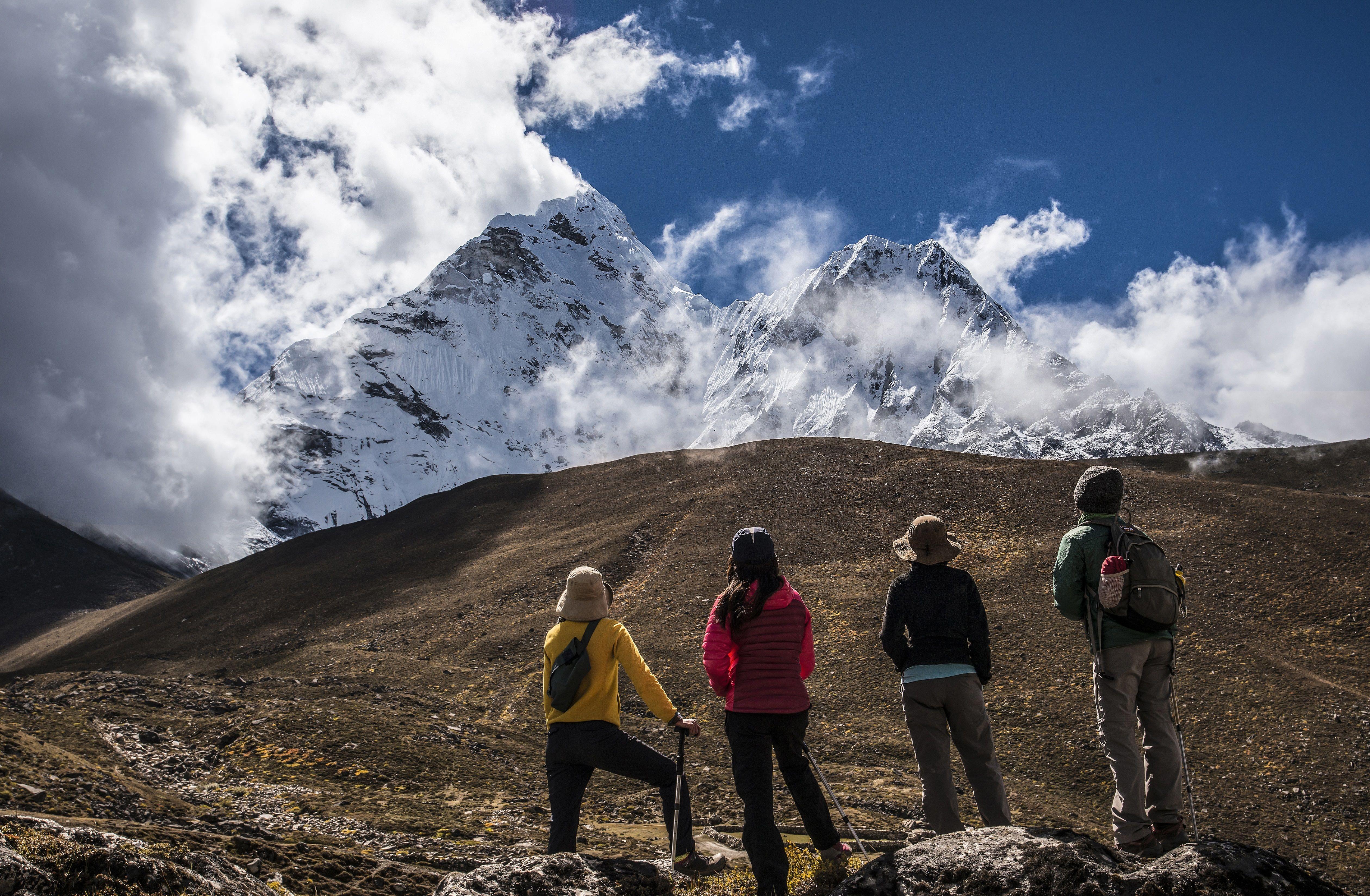Kanchenjunga Base Camp Trek Overview
Facts About Kanchenjunga Base Camp Trek
Kanchenjunga base camp Trek is one of the highest treks that takes you to an altitude of 17,000 ft.
This trek can be enjoyed by intermediate to pro trekkers as it is moderate-difficult. The trail takes you through dense forests, meadows, snow-clad summits, and secluded regions with steep climbs on moderate to rough terrain.
The trek is difficult because you will cover a distance of 90 kilometers in 11 days. The base camp of the trek is Yuksom, Sikkim and the nearest railway head is New Jalpaiguri.
The Bagdogra airport is at a distance of 160 kilometers from Yuksom. Due to staggering heights, mobile network services have no signals.
The best time to experience this trek is around the Summer season- May to June as the temperatures reach up to 25°C in Yuksom and 15°C at Dzongri.
These conditions make the weather comfortable to travel long distances as snow doesn’t hinder the trail.
After mid-September, temperatures fall as winters start to kick in, leading to excessive snowfall. Hence, no trek is allowed during this time.
Short Itinerary For Kanchenjunga Base camp Trek
Detailed Itinerary of Kanchenjunga Base Camp
Drive from Bagdogra Airport/NJP to Yuksom (5,670ft)
Transfer from Bagdogra Airport or New Jalpaiguri Railway Station to Yuksom in 7 hours.
Witness the beauty of the Himalayas and Teesta River as you ascend the road.
Arrive in Yuksom at 5670 ft and check in the hotel to rest overnight.
Trek from Yuksom to Sachen (7,150ft)
Start trekking for 5-6 hours to Sachen.
Start ascending along the valley of Rathong River.
Move through dense magnolia, firns, and rhododendrons towards Paha Khola Bridge.
Eat lunch mid-way to keep yourself energized.
Catch a glimpse of playful monkeys as you come across colorful flowers and blooming orchids.
Reach Sachen at 7,150 ft to rest for the night.
Trek from Sachen to Bhakim (8,600ft) to Tshokha (9,700ft)
Trek through aromatic viburnum plantations and cross PreK Chu River.
Ascend for 2-3 hours to reach Bakhim, and halt for some time.
Start Kanchenjunga base camp trek to Tibetan refugee settlement Tshoka at 9,700 ft and stay overnight.
Trek from Tshokha to Phedang (12,000ft)
Ascend through the rhododendron forests for 4 hours to reach Phedang at 12,000 ft.
Stay overnight at the campsite.
Trek from Phedang to Dzongri (12,980ft)
After having breakfast, start trekking to reach the Dzongri campsite area at 12,980 ft.
Experience the mesmerizing views of Koktang, Rathong, Simvo, Khangchendzonga, Kabru, and Pandim Himalayan Peaks.
No Trek Day at Dzongri- This day is to recharge you up as you spend leisure time exploring around the camp.
Trek from Dzongri to Thangshing (12,900ft)
Start Kanchenjunga base camp trek slowly for around 1 mile towards a low ridge at an altitude of 13,500 ft with the views of Kanchenjunga and Pandim Peaks.
Get enchanting views of chortens and colorful prayer flags.
Descend to Pandim through rhododendron forests along Prek Chu River.
Have a lunch break at a trekking lodge nearby.
Trek for 1.5 hours to reach Thangshing at an altitude of 12,900 ft and stay overnight in tents.
Trek from Thansing – Goecha La (16,000ft) – Lamuney
Ascend through moraines in the early morning as harsh climate may hinder the journey.
Descent to Samiti lake and cross Zemathang Plateau.
Ascend through moraine for another hour and reach Goecha La Pass at an altitude of 16,000 ft- the topmost peak in the trek.
Witness the beauty of Kanchenjunga and other mighty Himalayas from this magnificent pass.
Descend to Lamuney and camp beside Samiti Lake for the night.
Trek from Lamuney to Tshoka
Start early in the morning and descend to Tshoka.
Trek through Dzongri Plateau, Prek Chu River, and Phedang forests.
Trek for 7-8 hours to Tshoka at an altitude of 9,700 ft and rest overnight in camps.
Trek from Tshokha to Yuksom
- Descend for 5-6 hours through Prek Chu and arrive in Yuksom.
- Check in at a local hotel for the night.
Departure from Yuksom
- Get up in the morning to have a delicious breakfast and leave for your destination as the Kanchenjunga base camp trek ends here.
What To Pack For Kanchenjunga Base Camp Trek?
- Backpack 35-40 Ltrs.
- Small Day pack 20 Ltrs (carry your trail, camera, and water.)
- Water bottles, snacks like biscuits, protein bars, glucose-based chocolates, cup noodles, dry fruits, and quick energy bites
- Hiking pants/trousers and shirts
- Trekking shoes that are suitable for any terrain
- Flashlight with extra batteries
- Sunglasses
- Toothbrushes, toothpaste, soaps, tissues, moisturizer, cold coral, sanitizer, and anti-fungal cream
- Medicine kit
- Camera
- Water bottle
- Warm jacket/pullover
- Several gloves and socks
- Raincoat- in case of an emergency
Know Before You Go to Kanchenjunga Base Camp Trek
You should be physically fit as you ascend and descend hills multiple times to cover 90 kilometers in Kanchenjunga base camp trekking.
Since the trek reaches a height of 17,000 ft, oxygen is less at this altitude. You should perform altitude acclimatization to be comfortable and fit.
Practice the technique of ventilation as atmospheric pressure drops at such high altitudes with reduced oxygen inhalation.
The sudden drop in oxygen may cause discomfort like headaches, hypoxic conditions, vomiting, and other health problems. So, carry medicines and take necessary measures to avoid these.
Make sure to train yourself well before the trek as it is a long journey with moderate to difficult level trails.
Visit a doctor before the trek to test your fitness level and other mandatory checkups.
Avoid planning to trek during monsoons and winters as the trail is inaccessible and blocked.
Carry cash with yourself as there is no ATM or UPI facility beyond Yuksom.
There would be no mobile phone network after Yuksom. Hence, you should inform your family and dear before going on the base camp trek.
Have adequate sleep of 7-9 hours during the days of your trek as moving restlessly would hinder your journey keeping you uncomfortable.
Carry a 35-40 liter backpack for keeping all the necessary items.
By Air: Take a flight to Bagdogra airport, located at a distance of 160 kilometers from Yuksom, Sikkim. The airport is accessible from any metropolitan city, but a bit pricier than Kolkata airport. From Bagdogra Airport, you can get a taxi to reach Yuksom.
By Train: New Jalpaiguri or NJP Railway station is located southwest of Sikkim at 150 kilometers. You can board any long-distance train that directly reaches NJP. Another quick option is to reach Kolkata, as the railway station is directly accessible from major Indian cities. Once you reach Kolkata, you can board a train to reach NJP. From NJP, you can get a taxi to Yuksom.
The best time to try Kanchenjunga base camp trek is during Summer and Autumn seasons.
Season-wise breakdownSummer (May – June)The temperatures in Yuksom range from 15°C to 25°C during the day and 8°C to 15°C at night. In Dzongri, the temperatures range from 7°C to 15°C in the daytime and 3°C to (-2) °C at night. These temperatures are bearable and the parts of the trail bloom with lush greenery, but a bit hotter during the day.
Monsoon (July to Mid-September)The trek is inaccessible during this season as rain makes the trails slippery and the roads get blocked.
Autumn (Mid September to end of October)The temperatures in Yuksom range from 13°C to 20°C during the day and 2°C to 7°C at night. In Dzongri, the temperatures range from 7°C to 2°C in the daytime and 3°C to (-4) °C.This time is comfortable as meadows become greener and flowers bloom, making the trek easy and joyful.
The first day marks your arrival in Yuksom, Sikkim, at an altitude of 5,670 ft. You will check in to the booked hotel and rest for the night. The next day or the first day of the Kanchenjunga base camp trek, you will reach Sachen at 7,150 ft after crossing the Rathong river and dense forests. After a healthy breakfast, you will trek from Sachen to Bakhim crossing Viburnum Plantations and Prek Chu River. After halting at Bakhim, you will trek to the Tibetian refugee settlement Tshoka at 9,700 ft. The next day you will trek to Pedang at 12,000 ft after crossing rhododendron forests. Waking up early next time, you will reach Dzongri at 12,980 and stay there for the next day to relax and recharge. Day 7 will take you to Thangshing at 12,900 ft to witness the beauty of the Kanchenjunga peaks. The next day you will reach the highest place of GoechaLa at 16,000 ft and witness the mesmerism of the Himalayas. After spending some time, you will start descending to Lamuney. The next day, you will descend to Tshoka in 7-8 hours. On the second last day, you will reach Yuksom, the base camp, and rest in the local hotel overnight. The trek package will end on the final day after you check out from the hotel and reach your destination.
General Trivia About The Kanchenjunga Trek
Legend says that a mountain deity known as Dzö-nga, meaning 'Kangchenjunga Demon' lives in these mountains. In 1952, a British group of mountaineers spotted a strange creature, which locals referred to as the ‘Kangchenjunga Demon’.
According to the people of Sikkim, Nepal, and Tibet, there is a hidden valley on the slope of Kanchenjunga base camp trek mountain, which makes the visitor immortal. This valley is known as ‘Beyul Demoshong’ to Tibetan monks, who once went with 300 people to open its so-called doors.
Why to Go for Kanchenjunga Base Camp Trek?
FAQs of Kanchenjunga Base camp Trek
How Difficult is the Kanchenjunga Base Camp Trek?
The Kanchenjunga base camp trek ranges from moderate to difficult levels due to multiple factors, one of them being huge altitude gain. Yuksom at 5,670 ft and takes you as high as 16,000 ft. Although you travel to Yuksom by cab/bus, still you gain 5,670 ft in a single day. The entire trek will give you an altitude gain of 16,000 ft over 11 days, with an average of 1,455 ft every day. Another factor for the toughness is that you are required to ascend and descend 90 kilometers on a steep trail with quick climbs. To win big in this trek, you should train every day to walk 8 kilometers successfully to be able to take up this trek.
Where does the Kanchenjunga base camp or Khangchendzonga start?
It starts in a small time named Yuksom, Sikkim. The northeastern town was once a home to Chogyal kings, now importantly known as the base camp of the Kanchendzonga trek. You will reach Yuksom after crossing the beautiful Legship bridge and witness the Teesta River on the way.
How long does it take to reach the Kanchenjunga base camp?
On the 8th day of the 11-day Kanchenjunga base camp trek, you will reach the highest point of the trek at 16,000 ft. You can do it on the 7th day as well but the 6th day is required to rest and freshen up the trekkers.
Why is the Kanchenjunga base camp trek so dangerous?
It is not dangerous, it is just difficult as it requires you to trek for 90 kilometers on a moderate to challenging trail. On some days, you will be gaining more than 1000 ft in a single day- leading to the risk of altitude sickness. So, you should carry your medicine kit and take precautions.
Would I get altitude sickness at such heights? If yes, how can I avoid them?
Regularly drinking water can stabilize the body. There are times when you will trek more than 1000 ft per day, you must avoid Elevation sickness by adequate sleep. Pre-training leads to a healthy foundation of good acclimatization and control of problems related to altitude.
Is it safe to trek to the Kanchenjunga Base camp?
Yes, Kanchenjunga base camp trekking is completely safe as the trek is smartly planned. You will even be resting on day 6 at Dzongri to re-energize yourself. Besides the plan, you will be provided with a reliable and knowledgeable trek guide.
What is the level of fitness expected from the participants for the Kanchenjunga Base Camp Trek?
As the Kanchenjunga trek is a long journey covering 90 kilometers, you must be fit enough to walk such a distance. You can try to hold 15 kg weight and walk for 8-10 kilometers per day.
.png?w=auto&h=400)






